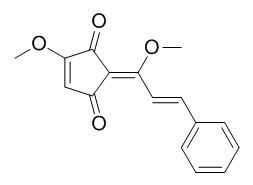Methyllucidone
Methyllucidone may have a neuroprotective potential via inhibition of neurotoxic microglial activation implicated in neurodegeneration.It can strongly inhibit the growth of human cancer cells and colon tumor xenografted in nude mice, the anti-tumor effects are further confirmed with caspase-3 activation and degradation of PARP. Methyllucidone shows 85% antifungal activity at 50 against the disease wheat leaf rust.
Inquire / Order:
manager@chemfaces.com
Technical Inquiries:
service@chemfaces.com
Tel:
+86-27-84237783
Fax:
+86-27-84254680
Address:
1 Building, No. 83, CheCheng Rd., Wuhan Economic and Technological Development Zone, Wuhan, Hubei 430056, PRC
Providing storage is as stated on the product vial and the vial is kept tightly sealed, the product can be stored for up to
24 months(2-8C).
Wherever possible, you should prepare and use solutions on the same day. However, if you need to make up stock solutions in advance, we recommend that you store the solution as aliquots in tightly sealed vials at -20C. Generally, these will be useable for up to two weeks. Before use, and prior to opening the vial we recommend that you allow your product to equilibrate to room temperature for at least 1 hour.
Need more advice on solubility, usage and handling? Please email to: service@chemfaces.com
The packaging of the product may have turned upside down during transportation, resulting in the natural compounds adhering to the neck or cap of the vial. take the vial out of its packaging and gently shake to let the compounds fall to the bottom of the vial. for liquid products, centrifuge at 200-500 RPM to gather the liquid at the bottom of the vial. try to avoid loss or contamination during handling.
Semyung University2017, 149407
Journal of Food Engineering2024, 379:112136.
Pharmacia2024, 71:1-9.
J Med Food.2021, 24(2):151-160.
Oxid Med Cell Longev.2022, 2022:9139338.
Phytochem Anal.2013, 24(5):493-503
Molecules 2022, 27(3),1047.
Bull. Natl. Mus. Nat. Sci.2021, 47(2),109-114.
Chinese Medicine2019, 14(1)
Malaysian J of Fundamental and Applied Sciences 2018, 14(3):368-373
Related and Featured Products
Eur J Pharmacol. 2012 Sep 5;690(1-3):4-12.
Neuroprotective effect of methyl lucidone against microglia-mediated neurotoxicity.[Pubmed:
22683871]
The microglial regulatory mechanism of Methyllucidone, a cyclopentenedione isolated from the stem bark of Lindera erythrocarpa Makino, was investigated in the present study.
METHODS AND RESULTS:
Methyllucidone treatment (0.1-10 μM) significantly inhibited lipopolysaccharide (LPS, 100 ng/ml, 24 h)-stimulated nitric oxide (NO) production in a dose-dependent manner in both primary cortical microglia and BV-2 cell line. Moreover, it strongly inhibited LPS-stimulated secretion of pro-inflammatory cytokines, such as interleukin 6 (IL-6) and tumor necrosis factor α (TNF-α). Methyllucidone treatment markedly induced down-regulation of LPS-induced nuclear translocation of nuclear factor κB (NF-κB) through preventing the degradation of the inhibitory protein IκBα. In addition, phosphorylation of Akt and mitogen-activated protein kinases (MAPKs) such as extracellular signal-regulated kinase (ERK) and p38 kinases were also suppressed by Methyllucidone. The cell viabilities of HT-22 neurons were significantly attenuated by treatment of the conditioned media containing neurotoxic secretary molecules from LPS-stimulated microglia. However, Methyllucidone significantly blocked neuronal cell death induced by microglial conditioned media. These neuroprotective effects of Methyllucidone were also confirmed in a neuron-microglia co-culture system using EGFP-transfected B35 neuroblastoma cell line.
CONCLUSIONS:
Taken together, these results suggest that Methyllucidone may have a neuroprotective potential via inhibition of neurotoxic microglial activation implicated in neurodegeneration.
Bioorg Med Chem. 2005 Nov 15;13(22):6182-7.
Cyclopentenediones, inhibitors of farnesyl protein transferase and anti-tumor compounds, isolated from the fruit of Lindera erythrocarpa Makino.[Pubmed:
16055336]
The microglial regulatory mechanism of Methyllucidone, a cyclopentenedione isolated from the stem bark of Lindera erythrocarpa Makino, was investigated in the present study.
METHODS AND RESULTS:
Methyllucidone treatment (0.1-10 μM) significantly inhibited lipopolysaccharide (LPS, 100 ng/ml, 24 h)-stimulated nitric oxide (NO) production in a dose-dependent manner in both primary cortical microglia and BV-2 cell line. Moreover, it strongly inhibited LPS-stimulated secretion of pro-inflammatory cytokines, such as interleukin 6 (IL-6) and tumor necrosis factor α (TNF-α). Methyllucidone treatment markedly induced down-regulation of LPS-induced nuclear translocation of nuclear factor κB (NF-κB) through preventing the degradation of the inhibitory protein IκBα. In addition, phosphorylation of Akt and mitogen-activated protein kinases (MAPKs) such as extracellular signal-regulated kinase (ERK) and p38 kinases were also suppressed by Methyllucidone. The cell viabilities of HT-22 neurons were significantly attenuated by treatment of the conditioned media containing neurotoxic secretary molecules from LPS-stimulated microglia. However, Methyllucidone significantly blocked neuronal cell death induced by microglial conditioned media. These neuroprotective effects of Methyllucidone were also confirmed in a neuron-microglia co-culture system using EGFP-transfected B35 neuroblastoma cell line.
CONCLUSIONS:
Taken together, these results suggest that Methyllucidone may have a neuroprotective potential via inhibition of neurotoxic microglial activation implicated in neurodegeneration.
J.Korean Soc. Agr. Biotechnol., 2003,46(2):150-3.
Isolation of Antifungal Active Compounds from the Leaves of Lindera erythrocarpa.[Reference:
WebLink]
METHODS AND RESULTS:
Methanol extract obtained from Lindera erythocarpa leaves was successively fractionated with n-hexane, ethylacetate, n-butanol, and . From ethylacetate fraction, an active fraction was isolated through repeated silica gel column chromatography and recrystallization, and was identified as a stereoisomer complex of Methyllucidone by MS and MMR analyses.
CONCLUSIONS:
The complex showed 85% antifungal activity at 50 against the disease wheat leaf rust.



